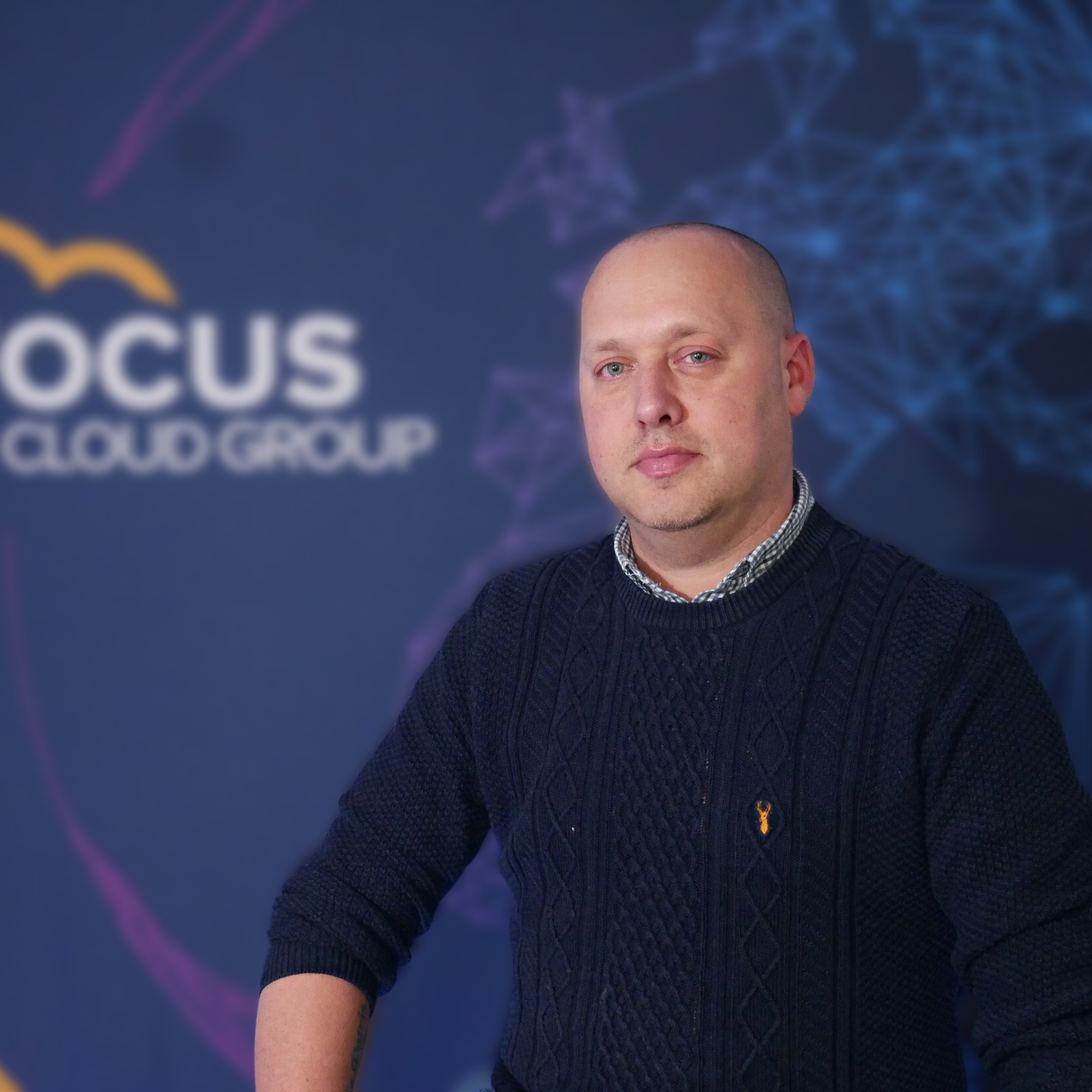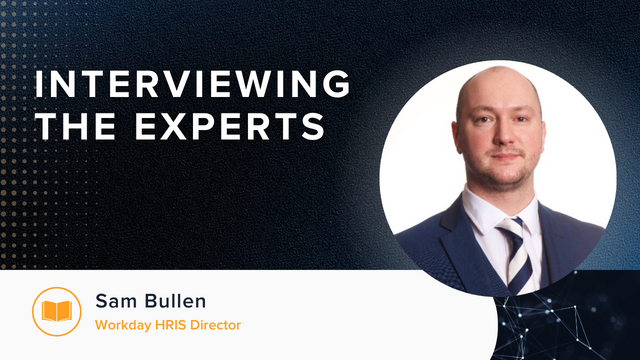Welcome to the next instalment of our Interviewing the Experts series.
We’ve been tapping into our client and candidate network to bring you the most relevant, on-point conversations with experts from the Workday® ecosystem.
Simon Hill, our Workday UK Team Manager, spent some time with Sam Bullen, Workday HRIS Director. Sam has been part of the Workday® ecosystem for 15 years, in various roles including Implementation Partner Consultant, in-house roles for Workday® customers, Sales Executive within a Workday® partner, HRIS Director, and he’s also spent some time contracting over the years.
Sam has end-to-end implementation experience from a range of different viewpoints, and he joined Simon to answer some burning questions on building and leading Workday® teams.
Where should Workday® sit within a company: HR or IT?
For me, a Workday® team should be split between three main areas: functional, technical, and data.
Each of these areas attracts certain people, personalities, working practices and ambitions. It makes sense for someone with an integrations background to sit in IT as those skills are more transferable within that department.
However, it may not make sense for someone with a functional background, who has come through HR, to sit within IT. They’re more likely to have ambitions within the HR department, and understand and build relationships with HR people more easily.
Data can fall either side of the divide, and this depends on what they like to use the data for – is it to improve the systems across IT and HR landscapes? Or is to make strategic HR decisions?
For me, there’s definitely a strong argument for at least part of the Workday® team to sit within HR.
What are the key considerations for an HRIS Leader in the post go-live phase?
The main areas to focus on are configuration, change management, and governance.
When it comes to the first area, and this is particularly prevalent in bigger companies, a common mistake is to try and over-configure the Workday® system to try and please everyone. But in the end, this leads to nobody getting what they want. Once live, end-users can get stuck in processes that either take too long, create a bottleneck, or aren’t meeting legal or regulatory requirements. If you keep the configuration as simple as possible, and make decisions that force the client to harmonise their working practices, this usually leads to better results.
When it comes to change management, this often gets forgotten about some way into the post go-live phase. Everybody learns differently, and they don’t always have the time to read a quick reference guide or watch a video. One way to combat this is to build tips and help text into your processes, through either Workday®’s own tools, or bolt on systems like WalkMe. This can help end-users in real time. It’s also really important to make sure all of HR are on board with the strategy and benefits of using a system like Workday®; they will have a huge impact on how end-users feel about the system, and how they utilize it.
With governance, one of the most common occurrences is not formalizing this enough during an implementation. Ensuring you have clear, documented processes for change controls and design decisions will help manage those conversations with auditors and guide your systems team to follow correct procedures. No one wants to fail an audit!
Why is change management overlooked in so many cases, and what’s the impact of that?
Each company is different in terms of culture and ways of working. As much as an organisation may invest heavily up front in change management and governance during an implementation, this doesn’t always translate well once they’ve gone live, and people are using the system and the change management tools they’ve got in place.
Some companies do manage this very well, but I’ve found that often, those change management tools are not working or they’ve been put in and forgotten about. Everybody learns differently, they may not want to read a quick reference guide or watch a video. They might prefer to go to in-person training or regular Q&A sessions with the Workday® team.
The change control processes you have in place might just not work for your specific company. Sometimes, when you have your first audit, the auditors come up with something that you’ve never thought about before, and so those change control processes need to be revisited.
If you can try and gauge how these things are going to fall as early on as you can in your whole process and implementation, it’ll minimize the backlash you’ll get from end-users, auditors, or anyone else.
How do you build a Workday® team post-implementation?
I’d set up a Workday® team based on those three areas – functional, technical and data.
It’s important to have a good mix of in-house resources and external AMS support through a Workday® Partner. Workday® themselves will give you an accurate ratio of the internal resources that you need based on your company size, number of modules etc.
What I’ve found useful is keeping some resources from that initial implementation. If all of your contractors and consultants leave, and your internal stakeholders go back to their original day job, it can be difficult to keep the knowledge of why certain decisions were made.
How do you identify the skillsets you need for your team?
You need to look at what modules you’ve got. If you have internal people that are clued up on the modules you’re utilising, then you’ll get a lot of value out of those individuals.
If, however, you want to swiftly move on to phase two, and you need someone with Advanced Compensation experience, for example, you might not have that in-house. That’s when you need to seek the skillsets externally.
I once brought someone in-house into my team as a Change Manager. They weren’t seasoned in Change Management, but they were in the HR department, they’d been involved in the initial deployment, and they had fantastic knowledge from the implementation side, but also about the company culture. They built amazing relationships between my team and the end-users.
Your in-house person doesn’t necessarily need to know how to configure Workday®. If you’re embarking on an Advanced Compensation rollout, but you’ve got someone in-house that has a lot of Rewards experience, you could always use their skills and supplement with either a contractor or your AMS provider for the configuration side of it.
So it all depends on really understanding the skills you need – is it configuration skills, knowledge from the company side, or something different? Don’t pigeonhole people or look at cliched sets of skills. More often than not, one size doesn’t fit all.
What’s the value of working closely with a recruitment partner for these niche Workday® skills?
By partnering with a company that knows Workday®, knows HR systems, and the people that work within them, you’re going to benefit a lot more quickly as opposed to a non-specialist agency. You can stick a job advert out there and hope the right people apply, but it won’t get you anywhere fast.
People like yourselves (Focus on WD), you know what you’re doing, you’ve been doing it for years. You’ve already got numerous amounts of people on your books, and if you’ve not got the person your client is looking for, you know where to find them.
That’s the benefit that you’re going to get as a Hiring Manager – efficiency. The speed you’re going to get people in front of you for interview is going to help you fill that role a lot quicker.
What’s the Hiring Manager’s responsibility during a hiring process with a recruitment partner?
As a Hiring Manager, the key responsibility is to be open and honest with your recruitment partner, and utilize that relationship as soon as you possibly can. The longer you go before having those initial conversations, the longer you’ll take to decide what it is you’re actually looking for, and it’s going to extend the amount of time where bums aren’t on seats.
By being open and honest, again, you’re going to get the right person. You just want something to be done quickly and efficiently, and by adhering to those responsibilities as a Hiring Manager, you’re more likely to be able to do that.
Once we’ve placed a candidate with you, what do you have to do to ensure that candidate remains happy with their choice?
It’s really important to make sure that the people you’re bringing in are happy and content, and all their needs are met in terms of their career and the way they work. Because the thing is, with the Workday® ecosystem, it is incredibly easy to move around.
The demand is still outstripping the supply, especially with those more niche roles. So, you need to make sure you’re investing in those people, showing them that they are important and that they have real value within that team.
Your in-house staff, particularly, need to know that what they’re doing can benefit your company on an ongoing basis. When you talk about in-house roles, the work doesn’t involve just coming in, doing a job, then going away again – it’s always changing, along with the organisation. You’re always busy as an in-house HRIS specialist, and in many cases it can be quite a thankless role as well.
So, keeping those people happy, helping them to grow and develop, is what’s going to keep them in that company, and keep your attrition costs down.
What are Workday® skills worth to someone in your position, as an HRIS Director?
Investing in a system like Workday® is not a short-term fix for everything. Companies change, whether it’s structure, size, or strategy. Having someone in-house that knows your system’s capabilities will help a company make transitions quicker, and with fewer issues. The relationships I’ve seen between key stakeholders and internal systems teams can often be incredibly strong and valuable to a business.
Having people dedicated to your system and your company helps tackle any issues quickly, and gives you the knowledge and skillsets to ramp us as and when necessary. There’s only so much a CPO or CIO and their teams can know about Workday®, and it won’t ever be enough to answer everyone’s questions on a regular basis.
Having internal Workday® resources also helps a company to be proactive, instead of reactive. Your in-house Workday® pros are part of the Workday® community, attend sessions like HR Tech or Rising, for example. They can use that knowledge and that growth to work with your key stakeholders to help build out roadmaps, manage bianuual releases, and be ready for what’s around the corner.
We’ve found that Workday® pros seek good remuneration, career progression, interesting project pipelines and good company culture in equal measures when searching for a new position. As a Workday® leader, how do you offer them the whole package?
It can be tough, but it’s not impossible.
Investing in a system is an iterative process, and not something you’ll only do once. Part of that investment is the people who are going to get the most value out of that system for you. Happy systems specialists will mean lower attrition costs.
From a money perspective, I think it’s important to fairly pay your in-house resources. As opposed to contractors, your permanent members of staff are more likely to go that extra mile and not just invest in themselves and their team, but in the company itself. They’re often expected to take part in company initiatives, voluntary days, focus groups etc., and this helps build the relationships needed to get the value from your system. And, as I said, it’s often a thankless task. It’s a lot of responsibility, and these people deserve to be fairly compensated for that.
When it comes to career progression, as we discussed before, everybody has different personalities and ambitions. For Functional Consultants, giving them the ability to learn as much about Workday® as possible, and to grow within the company, will inspire loyalty from them, and bring more value to you.
If you’re investing in systems correctly, there will always be interesting work to do.
In terms of culture, it’s something a worker should be aware of when joining a firm, if not on day one then soon after. Regular check-ins with them will help them blend in, make sure they’re coping with the workload and company expectations etc., and help with this side of things.
Thank you Simon and Sam for such an interesting and enlightening conversation. Sam’s insights are absolutely invaluable to anyone thinking about implementing Workday®, or who is leading a Workday® team through the post-implementation phase.
If you are implementing Workday®, or some of the post go-live considerations that Simon and Sam discussed need some attention in your Workday® programme, Focus on WD can help. As Sam described, we specialise in Workday® recruitment, have been doing it for years, and have a great network of candidates to call upon. If we don’t have what you’re looking for, we know where to find them. Get in touch today if you’d like to start a conversation about how a partnership could benefit you.
Prefer video? You can watch this episode here.




